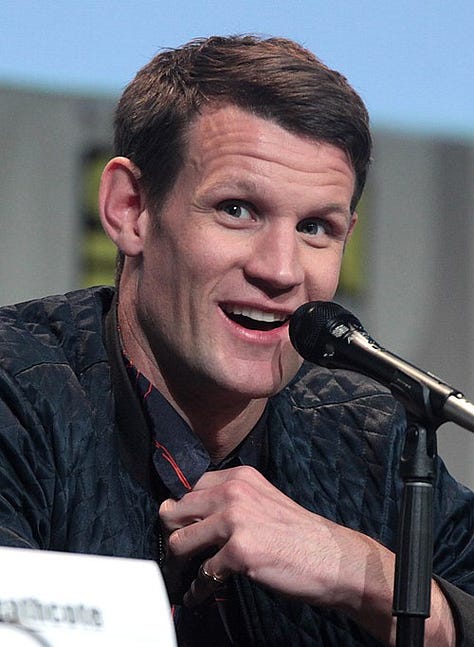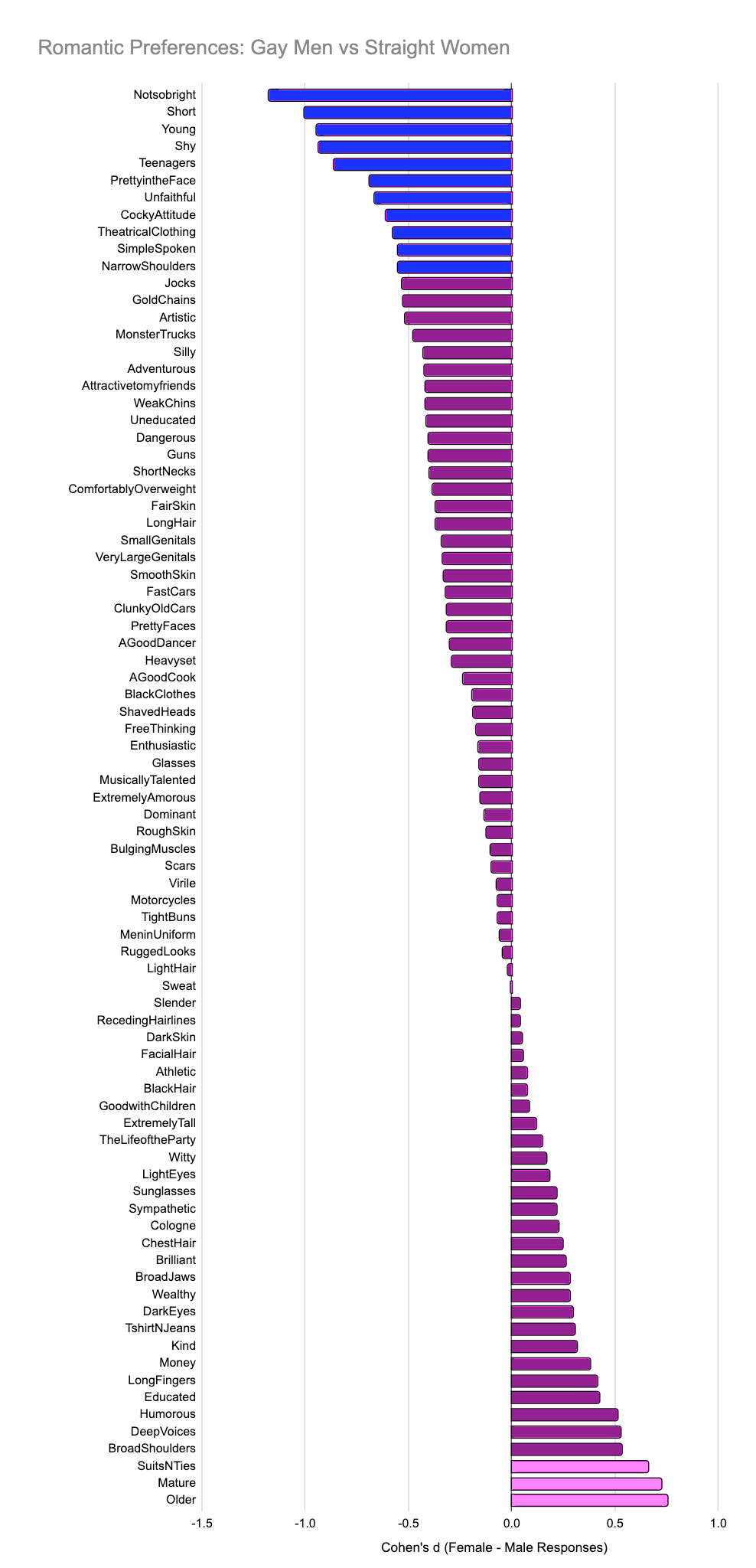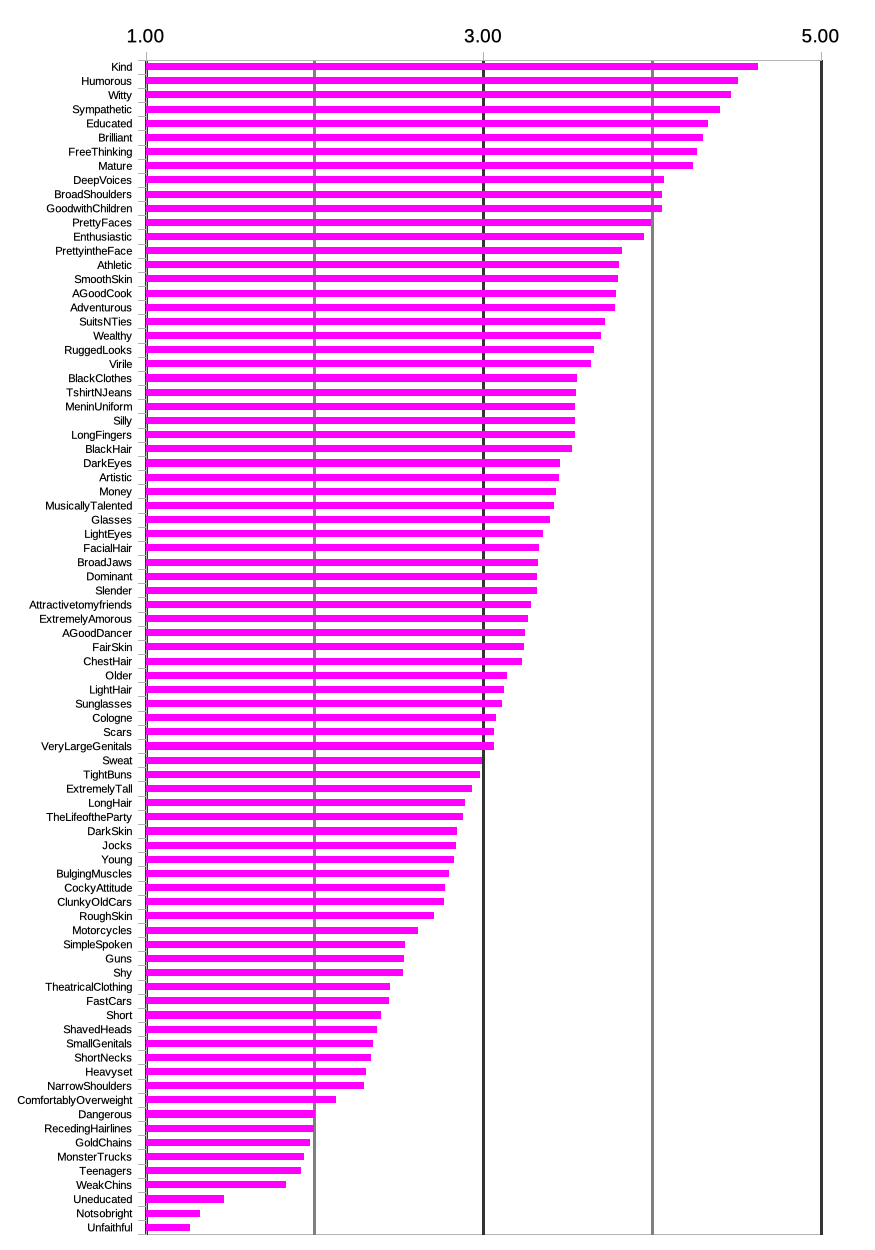When the wicked queen of Scheewittchen asks her mirror mirror on the wall about who is fairest, there’s an underlying assumption that womanly beauty is an obvious, unquestionable, even tangible thing. And while she becomes only more enraged each time the mirror tells her she is not the most beautiful woman, the queen never takes a skeptical position or seeks to argue with the glass. She may be evil, but she knows better than to whinge or squirm or hide behind platitudes about beauty being rooted in patriarchy.
This wasn’t for lack of such ideas at the time. Philosophers like Hume were telling everybody in the 18th century that beauty was merely in the eye of the beholder, and it was only the unreflective or unphilosophical who believed beauty to reside in a person. But a 2000 meta-analysis found respondents broadly agree about adult facial beauty—this was the case regardless of the respondents’ own age, or their own ethnicity, or their country of origin.1 Granted, agreement was never perfect; any given pair of raters described in that paper only showed moderate agreement regarding the beauty of different faces (r = 0.47, p < 10-88). But overall, psychological science comes down on the side of the magic mirror: though all eyes may be different, they can still perceive the same shining beauty in Scheewittchen, a beauty the evil queen cannot match.
Yet when it comes to masculine attractiveness, the matter seems somewhat more muddled—and when we turn away from beauty per se to the question of romantic appeal, the magic mirror’s clarity evaporates entirely. Women flock to men like Steve Buscemi, Matt Smith or Serge Gainsbourg in a way that makes one wonder what’s going on.



So if it isn’t looks, OK, the scientific literature suggests that maybe it’s humor,2 or storytelling ability3, or broad shoulders,4 or resource acquisition5 (but maybe not actual wealth?6) that really matters. Women are strange, after all; scientific reports claim that androphilic women—that is, you know, straight chicks—get aroused by watching nonhuman primates mating,78 and then other reports find that’s a bunch of unreplicable nonsense,9 but check the dates on those studies and you’ll notice it takes everybody about a decade to figure it out, that’s how clueless we all are about what women want. And so long as all this doesn’t seem to answer the question, hey, the Internet at large is quick to supply an entire suite of characteristics like grooming, style, posture, smiling, genuine interest, and authenticity that make a man really smolder.
But is any of this right? What is it that truly matters to people looking for a man?
Well, at the start of this year, I began two surveys on romantic preferences trying to answer this question. The first survey was about what people found attractive in women, which, while interesting, didn’t tell me very much that I didn’t already know. It was the second survey, about what people found attractive in men, that I was particularly keen to analyse. This post is about the very basic aspects of what I found in the second survey: the overall, average ideals of people attracted to men.
This survey was much longer in reaching completion than the other. This may be because the author of this blog is male, and despite being rather left of center, has explicitly anti-woke attitudes which are exactly the sort of thing the ladies find tiresome these days; I doubt my readership is even close to balanced across the genders. However, others have suggested that there is a genuine gender difference here: ladies are not particularly keen on participating in surveys asking them questions about their romantic interests. On the one hand this strikes me as rather odd, given the longstanding female enjoyment of romantic fiction, which is very much an exploration of what readers find attractive in other people. But on the other hand, it is hard not to notice the way women are less forthcoming about many things than men—women are known to be much more sensitive, nervous, and fearful than men, and as a consequence are less likely to chafe at restrictions on free speech.
I fact, this is a finding I replicate with these surveys: the male respondents were quite committed to free speech, agreeing with the statement “Free speech is important, and should be protected even if some people's feelings are hurt,” significantly more than the female respondents.10
So let’s all pause for a moment and be grateful that 203 ladies (and also 32 gay guys, and one illustrious other) shared with us their responses so that we can finally get some idea about what in the world is interesting about men.
Mister Romantic Average
To develop a precise picture of the average romantic ideal casting one’s nets very wide, trying to sample people as carefully as possible to see that everyone is appropriately represented. This often proves not only expensive but extremely difficult, as the surprise election of Donald Trump proved in 2016, when polls found the average voter supported Hillary Clinton, who went on to lose the election.
With only n = 236 respondents, drawn disproportionately from my Substack and from people affiliated with other bloggers like Tove, Kryptogal, and Sophie who helped promote the survey, there is little hope of a broad representation. However, it should be pointed out that this kind of analysis isn’t like a political election; it isn’t as though my respondents had to choose between two guys, and if I’m off by a few percent, I don’t know whom they’ll pick. Frankly I’m not worried about the details; I just want to see the general outline of Mr. Romantic Average—so here he is, in all his majesty:
Notice! Just as with Lady Romantic Average, described here, the top eight traits were all psychological: kindness, a sense of humor, sympathy. Maturity was slightly preferred over being good with children, and a deep voice is slightly more important than prettiness, but beauty is still strongly desired—the top of the lists is the same for a man as for a woman. And the same three traits sit at the bottom in the exact same order: uneducated, not so bright, and unfaithful. So already there is a strong similarity between what we want in a woman, and what we want in a man.
Many of the differences are unsurprising; when it comes to men we’re much less patient with youthfulness or weak chins, and value athleticism and broad shoulders much more in men than in women. But if all of these descriptors feel dry on their own, then as before I put the terms into AI to generate a visual representation.
Although he’s well dressed, likely to be financially independent, and at least vaguely respectable, let’s not gloss over his most noteworthy traits: kindness, intelligence, maturity, and a good sense of humor. As with Lady Romantic Average, we should note that it’s probably not indescriminate kindness that everyone wants as much as kindness towards me, my family, and my friends,11 but otherwise we have a clear contradiction to what the pickup artists have been desperately trying to convince men to do: being a jerk may get you a certain kind of partner, and good for you if that’s what you’re into, but that partner is not typical. Normal people want people who are smart, funny, mature, and predictably nice to them.
Those are the premium traits at the top tier—the traits that just about everyone really wants. After we get past these premium traits, we find that being pretty in the face does matter a lot as well, along with being wealthy, athletic, well dressed, broad shouldered, a good cook, and having a deep voice. These traits seem to be a bit more negotiable one versus another, and economists have even noticed how “men may compensate 1.3 additional units of BMI with a 1 percent increase in wages” (and women can compensate 2 points of BMI with 1 year of education).12
Keep going past these and we find the third-tier traits—things that are pretty nice, but not that important, and probably come down much more to individual taste: dark clothes, long fingers, silliness, virility, musical or artistic talent, wearing t-shirts or uniforms, glasses, and facial hair. I suspect that these things do a lot to confuse people, because while they are desirable, they just aren’t a big deal. Sure, beardstyle.net will give you 10 Reasons Why Women Like Beards, but if you’re a lonely dude trying to get girls—or a lonely gay guy trying to score with other men—you really souldn’t be thinking about beards nearly as much as how to build your education and social skills, broadening yourself with travel, or learning to cook. Those are the valuable traits everyone wants, much more than the ability to play the guitar or pick out a pair of glasses. Whatever you do, don’t go for a gimmick like an expensive car, a flashy hat, or gold chains; although people attracted to women can definitely be influenced by accessories, check the list above and you’ll see few people attracted to men are interested in cheap visuals.
But what about the Most Important Thing on a man?
Although I’d prefer to leave what I’m getting at here as a nod and a wink, some of my readership comes from foreign countries and doesn’t speak English as a first language, so I’ll be direct and say that I am talking about big dicks. Specifically I’d like to establish just how important is the bigness of a man’s big dick?
In the survey on attitudes towards women, I knew people tended to like large breasts, so to find out how large was ideal, I asked respondents if they liked “very large breasts.” I used the same trick in the present survey, and asked respondents not what they thought of guys who are large, but very large down there. Everybody knows the ladies like them large, but do they like them very large? And the answer was, well, by the time the most important thing gets very large, most people aren’t really sure it’s a good thing or not.
Yet even more striking is the way over half of the sample just didn’t care about the prospect of a man who was small, either:
Obviously a man’s size does matter. Obviously lines like “it’s not the size that counts, it’s how you use it” are mostly used ironically, because everybody knows it isn’t really true. In 2002, Donald Templar wrote a little known book on the subject, titled, Is Size Important? And it turns out that the majority of women claim the size of a man’s penis is “somewhat important,” and prefer men who are “average or above average.” (p. 66) But the takeaway here is that “the most important thing” isn’t actually that important. This isn’t even a second-tier issue. Size matters about as much as wearing a uniform.
Since most of my readers are heterosexual men who might find this conclusion suspicious or confusing, I’ll take a moment to validate your sense of this matter. I’m a straight guy who grew up with straight guys, and the general feeling among my circle of friends was either a profound sense of confidence or shame that came from whatever it was that the tape measure said. There’s a reason for this: heterosexual males are very visual and very physical in their attraction. Avenue Q tells us that the Internet is for Porn, and even a perfunctory perusal of pornography will present a plenitude of penises. But women aren’t turned on the same way that men are. Compared to men, the amount of pornography women consume is much less,13 and the amount of erotica they read is overwhelmingly greater.14 Yes, women care, yes, size matters, but in the grand scheme of things forget about it—it just doesn’t matter much.
Platitudes about how being overdressed is the key to success, or the way clothes make the man should give us a clue: most ladies aren’t that interested in bodies. It’s men’s presence, their confidence, their scent, their resonant voices that make men so alluring. If you don’t believe me, look at what people attracted to men think about height:
I should mention that height preferences were measured in a different way from penis size preferences. Instead of respondents being asked whether “height” was a turn off or turn on, they were given the opportunity to indicate how much they agreed with statements like “I’d like a romantic partner who is… short” or “I’d like a romantic partner who is… extremely tall.” And once again, while taller was better than shorter, the most common answer was still idc.
Could this different way of posing the questions be having an effect on the results? The answer here is no. When asked whether pretty faces are a turn off or turn on, and then subsequently whether people would like a romantic partner who is pretty in the face, the answers were very similar:
But how similar were they really? You can check the scaled averages in the pink chart above and see the two questions were only two places away from one another. It doesn’t matter how you ask the questions: people are telling us what they like, and when it comes to the question of whether physical traits like height or dick size or even finger length matter, most women are basically saying “yeah, sure,” but not “OMG.”
What About Gay Men?
Now this is also an interesting question. Although my sample was largely comprised of self-identified women, there were enough gay men to get a picture of the difference between what women and men like in a man. In the graph below, bars stretch to the left for preferences more strongly endorsed by gay men, and to the right for preferences more strongly endorsed by women:

Overall, the stronger differences at the top and bottom of the chart give an interesting picture of women liking respectable, well-dressed men, and gay men liking ditsy teenage boys.15 And this does line up with my personal experience; I had a lot of gay men hitting on me in my late teens and early 20s when I wasn’t necessarily very good at being polite while handing out rejections. On the other hand, female interest in me seemed to peak in my 30s, after I was already married.
In retrospect, this was actually really frustrating, but it isn’t that surprising. The stereotype has always been for men to want ditsy young things, while women often seem not to care about sensuality at all, and instead want somebody reliable, wealthy, and settled. And this is exactly what the survey results are telling us: this gender divide even exists between women and gay men—between people who agree about what gender they’re attracted to, but still don’t agree about what they’re looking for in a person.
In other words, men trying to understand women’s romantic interests has always faced three problems:
Firstly, the general reticense of women to speak as frankly as men do;
Secondly, the difficulty of imagining being attracted to men in the first place; and lastly,
The difficulty of figuring out what exactly it is about a man that women want.
So I’m deeply indebted to the women who answered this survey and clarified what exactly it is they really like. Although opinions do differ, on the average women don’t like bad boys, tough guys, or even undiscovered geniuses. On the whole, compared to what men might think women want, what women are actually looking for is someone who is older; someone who wears suits and ties; someone mature.16
In one sense, this is tragic news for all the weedy high school guys who are just too immature for most women to be interested in them. In another sense, the clear message is that if you can be patient and use your time wisely, don’t worry—you’ll find someone in the long run. And in the meantime:
Langois, Judith et al. (2000). “Maxims or myths of beauty? A meta-analytic and theoretical review.” Psychological Bulletin, 126(3), 390.
Wilbur, C. J., & Campbell, L. (2011). Humor in romantic contexts: Do men participate and women evaluate?. Personality and Social Psychology Bulletin, 37(7), 918-929.
Donahue, J. K., & Green, M. C. (2016). A good story: Men's storytelling ability affects their attractiveness and perceived status. Personal Relationships, 23(2), 199-213.
Gallup Jr, G. G., & Frederick, D. A. (2010). The science of sex appeal: An evolutionary perspective. Review of General Psychology, 14(3), 240-250.
Buss, D. M. (1989). Sex differences in human mate preferences: Evolutionary hypotheses tested in 37 cultures. Behavioral and brain sciences, 12(1), 1-14.
Tskhay, K. O., Clout, J. M., & Rule, N. O. (2017). The impact of health, wealth, and attractiveness on romantic evaluation from photographs of faces. Archives of Sexual Behavior, 46, 2365-2376.
Chivers, M. L., & Bailey, J. M. (2005). A sex difference in features that elicit genital response. Biological psychology, 70(2), 115-120.
Chivers, M. L., Seto, M. C., & Blanchard, R. (2007). Gender and sexual orientation differences in sexual response to sexual activities versus gender of actors in sexual films. Journal of personality and social psychology, 93(6), 1108.
Krejčová, L., Vaníček, O., Hůla, M., Potyszová, K., & Bártová, K. (2024). Genital and Subjective Sexual Arousal in Androphilic Women and Gynephilic Men in Response to the Copulatory Movements of Different Animal Species. Archives of Sexual Behavior, 53(8), 2977-2986.
The actual difference is less sensational than this makes it sound, though, since on a 1-5 scale men averaged 4.67 while women averaged 4.48, and you really need a t-test to know it’s significantly different (p = 0.0038).
More interesting is the fact that my respondents were so very, very supportive of free speech. In fact, men in my sample were more in agreement that speech should be free, even at the expense of people’s feelings, than they were that the ideal woman have delicate features, wear high heels, show a sympathetic disposition, or indeed have any given trait or characteristic. Frankly I can’t help but think you guys are a little nutty when you care about an abstract principle like free speech more than the intelligence, waistline, or kindness of your ladyfriends, but hey, that’s just me
Lukaszewski, A. W., & Roney, J. R. (2010). Kind toward whom? Mate preferences for personality traits are target specific. Evolution and human behavior, 31(1), 29-38.
Chiappori, P. A., Oreffice, S., & Quintana-Domeque, C. (2012). Fatter attraction: anthropometric and socioeconomic matching on the marriage market. Journal of Political Economy, 120(4), 659-695.
Harper, B (2025). Porn Statistics in 2025 (Latest U.S. & Global Data). https://mazeoflove.com/pornography/
Curcic, D. (2023, November 20). Romance Novel sales Statistics. https://wordsrated.com/romance-novel-sales-statistics/
Incidently, it’s also easy to generate a scale of overall interest in “the most important thing” by adding respondents’ interest in small genitals and very large genitals together: then we find d = -0.57, p = 0.02, meaning—at least in this sample—interest in dicks really is a male thing.
To put it another way: Fans of Metalocalypse probably think women are really into the long-haired, artistic, t-shirt-wearing, semihygenic, overtly aggressive band members, but the most attractive man on Dethklok’s team isn’t a member of the band.
This is weird enough to some men that, when they eventually figure it out, it sends them into a deep kind of soul searching confusion and disgust.









This is interesting, thank you!
Did factor analysis turn up any interesting clustering? I find myself wondering if there might not be archetypes with conflicting sets of features that different women find attractive, for instance. Maybe the "high class stable man" vs "roguish rambler" or something. It seems like there must be some sort of split for types like that which explains say Middlemarch and the dozens of other "which man will she choose?" types of stories. Or maybe they are just all competing traits that tend to clump together themselves, so different archetypes just happen to compare well with each other since one person can't have all the traits.
Women's taste still seems strange to me, and with 3 girls approaching their teenage years I find the topic suddenly concerning in a way it hasn't been for about 20 years :D
Men are weird. Women are boring. That was my main impression of your posts on your survey results.
But I think that women are a bit weird too. We are just better at hiding it from ourselves and others.